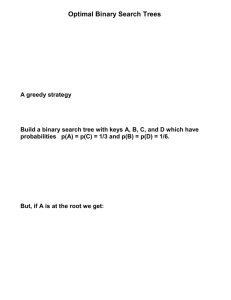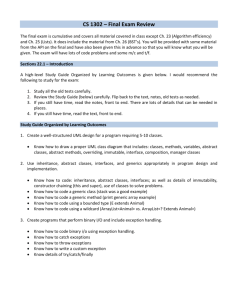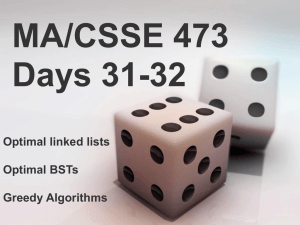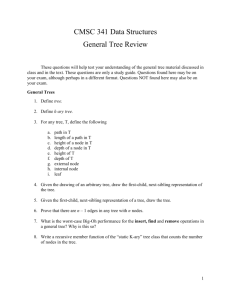Optimal Binary Search Trees
advertisement
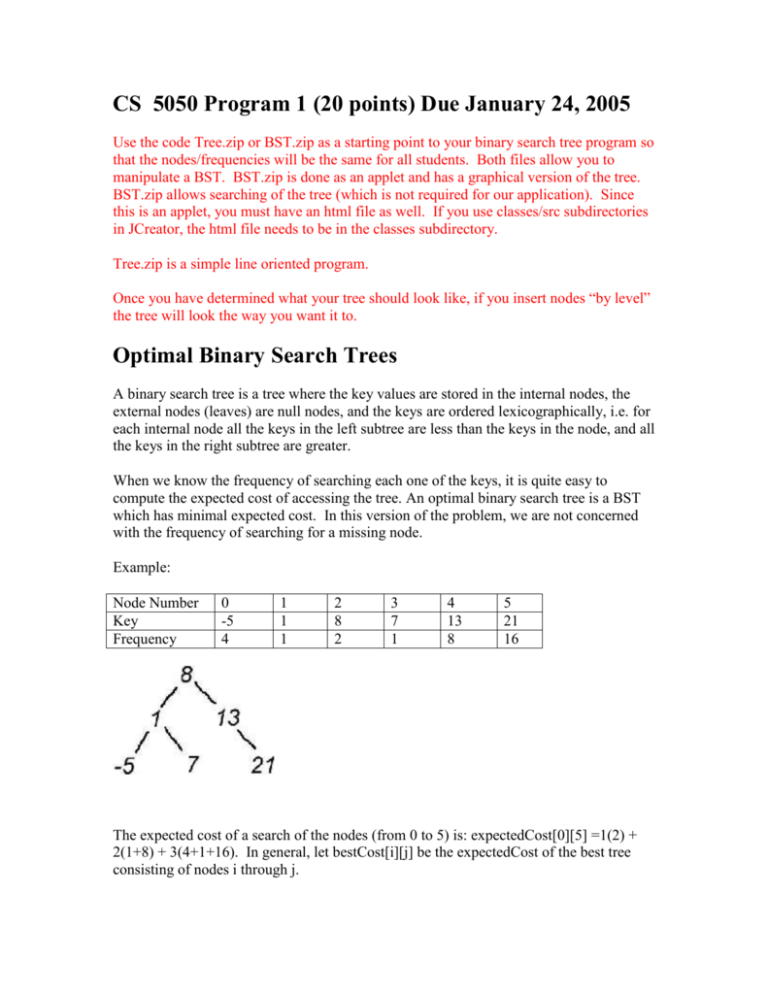
CS 5050 Program 1 (20 points) Due January 24, 2005 Use the code Tree.zip or BST.zip as a starting point to your binary search tree program so that the nodes/frequencies will be the same for all students. Both files allow you to manipulate a BST. BST.zip is done as an applet and has a graphical version of the tree. BST.zip allows searching of the tree (which is not required for our application). Since this is an applet, you must have an html file as well. If you use classes/src subdirectories in JCreator, the html file needs to be in the classes subdirectory. Tree.zip is a simple line oriented program. Once you have determined what your tree should look like, if you insert nodes “by level” the tree will look the way you want it to. Optimal Binary Search Trees A binary search tree is a tree where the key values are stored in the internal nodes, the external nodes (leaves) are null nodes, and the keys are ordered lexicographically, i.e. for each internal node all the keys in the left subtree are less than the keys in the node, and all the keys in the right subtree are greater. When we know the frequency of searching each one of the keys, it is quite easy to compute the expected cost of accessing the tree. An optimal binary search tree is a BST which has minimal expected cost. In this version of the problem, we are not concerned with the frequency of searching for a missing node. Example: Node Number Key Frequency 0 -5 4 1 1 1 2 8 2 3 7 1 4 13 8 5 21 16 The expected cost of a search of the nodes (from 0 to 5) is: expectedCost[0][5] =1(2) + 2(1+8) + 3(4+1+16). In general, let bestCost[i][j] be the expectedCost of the best tree consisting of nodes i through j. It's clear that this tree is not optimal. - It is easy to see that if the 21 is closer to the root, given its high frequency, the tree will have a lower expected cost. Criterion for an optimal tree: Each optimal binary search tree is composed of a root and (at most) two optimal subtrees, the left and the right. You are to solve this problem four ways: greedy, recursion, memoizing, and dynamic programming. Greedy With a greedy solution, you pick what appears to be the best node for the root (the one with the highest frequency), and then solve for the subtrees recursively (using a greedy heuristic). Note that a greedy solution may or may not be optimal. Show the solution produced. Recursion With recursion, you can try all solutions. A method which looks at all possibilities to find the best method is called an exhaustive method. The term exhaustive doesn't mean you will get tired computing it (although you will), but that you exhaust all possibilities. Show the solution produced. Memoizing Memoizing refers to writing yourself a memo saying, ``Hey, don't compute this again! You've already done it once.'' Rewrite the recursion with the following change. Initially, set bestCost[i][j] to -100 to represent the expected cost of the optimal tree from i to j. Then as you compute the values recursively, if bestCost[][] has already been computed, don't recompute it. Dynamic Programming In some recursive solutions (without memoizing), work is increased because you keep solving the same subproblem. The idea of dynamic programming is to save all the solutions to the subproblems so you can reuse them. One difference in a dynamic programming solution is that you normally start with the smallest subproblem and determine the solutions for larger and larger subproblems (in terms of the smaller ones). Thus, you build the value array starting with main diagonal of the bestCost matrix. There is no recursion in dynamic programming, so the method looks quite different than the other two. Create an option to use this method and display both the matrix and the tree produced. Submission Modify the code provided so that the created nodes (20 of them) are made into an optimal binary search tree. 1. Display the tree created by the greedy heuristic. 2. Display the tree created by recursion. 3. Solve the problem using memorizing. Print the table you create via memozing and the resulting optimal binary search tree. 4. Solve the problem using dynamic programming. Print the dynamic programming table so that we can see what the algorithm does. Display the resulting optimal binary search tree. As you may suspect, grading for a class of this size is a time consuming task. We need each student to facilitate grading. Never use paths which are specific to your machine. Make it as easy as possible for the grader to run your code. Be sure to read the assignment carefully so you are not docked for easy things you forgot to do. Some students want the grader to continually regrade their assignments as they correct various omitted features. The grader doesn't have time to do this. Get it right the first time! Report (printed by your program before the program output is printed) 1. In general, when is dynamic programming better than recursive programming? 2. How many hours did you spend on this problem?
